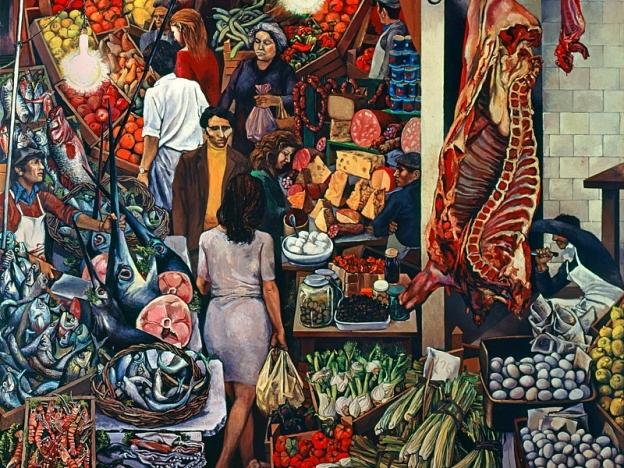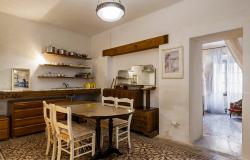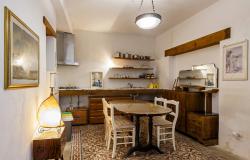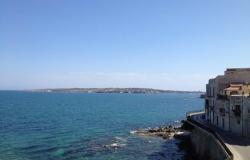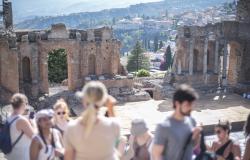[Image above: Renato Guttuso, 'La Vucciria']
Welcome to John's Gallery of Sicilian-related artwork! I'll be taking you on a tour of some of the most notable pieces of art linked with Sicily – whether it's Sicilian-born artists or pieces painted in the region. Some of the most innovative, detailed and enduring paintings have been linked with Sicily. So first of all, let's go back in time to an era in which the expression of art was beginning to truly flourish...
RENAISSANCE MAN
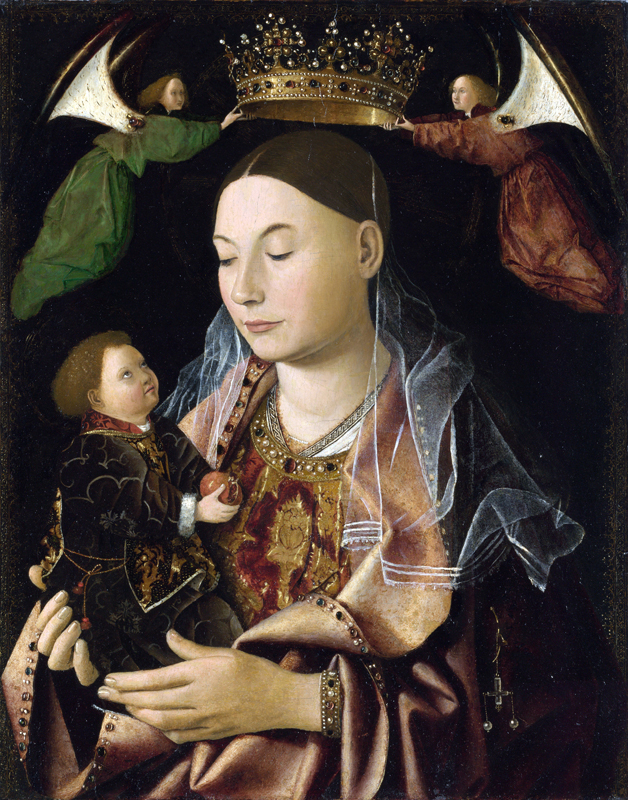
The Renaissance was a time in which art summed up the ethos of the era. Artists were able to fully express their individuality, technique and talent through painting and drawing. One such example was Antonello da Messina (nee Antonello di Giovanni di Antonio). Antonello is one of Sicily's best known painters and many of his examples showcase the Renaissance style at its best. Take the Madonna With Child painting from the 1460s. Also known as the Salting Madonna (named after George Salting, a collector who donated the painting to a gallery in 1910), this painting reinforces many of the Renaissance era's key element: attention to detail – such as the ornate costumes, the crown and the details on the faces.
[Antonello da Messina, "Madonna with Child", or "Salting Madonna"]
The symmetry of the picture is typically precise with the Madonna centred in the middle and the two angels holding the crown above at opposite ends. There's also symmetry in the opposite ends of the spectrum with respect to colour. Look how the rich costumes highlight the pale skin of the Madonna. The Madonna's face is said to have been inspired by contemporary Provencal artists with an abstract, distant quality.
Another good example of Renaissance-style art is the San Cassiano Altarpiece which was commissioned for the Church of San Cassiano in Venice in 1475. The piece comprises the Virgin Mary sitting on her throne along with the saints St. Nicholas of Bari, St. Mary Magdalene, St. Lucy and St. Dominic.
What characterises the Renaissance flavour of this painting is the precise symmetry in which the saints surround the Virgin Mary. One of the most notable techniques of the Renaissance is using light and shade, and the use of light in this piece cleverly forms a kind of pyramid layout of the participants. In addition, there is the intense detail of the clothes, the facial expressions and the contrasting tones of the pale skin and the rich clothes.
The exquisitely detailed St. Jerome In His Study is another superb example of Antonello da Messina at his best. It's a piece that again utilises light techniques to sum up a point of view. The painting puts greater emphasis on St. Jerome by placing the spotlight on him with the bookending sides shrouded in shadow. So the painting offers a unique perspective – as if whoever is looking at this piece is actually right there in the doorway to the building.
TRIO OF TRIUMPH
Influence from the Renaissance would make its mark on future generations. Techniques and styles would be used down the line. For example, Caravaggio would use some of these notable styles of light in pictures such as the 1609 Raising Of Lazarus.
Now I know what you're thinking. Caravaggio (dubbed the most famous painter in Rome) was Milanese-born. Born Michelangelo Merisi, he was one of the foremost painters of his time. But where does he fit into Sicily?
Well, the story goes that Caravaggio had escaped from a Maltese prison, and planned a hideaway in Syracuse. He was aided by his companion, Mario Minniti, who helped him get commissions for three pieces of work in the area. Burial Of St. Lucy was Caravaggio's first commission in the area in 1608. This was painted for the Franciscan Church of St. Lucia at Sepolcro (St. Lucy was the patron saint of Syracuse). The following year, Caravaggio produced the Raising Of Lazarus for the Church of the Padri Crociferi. This was a good example of how Caravaggio used lighting techniques to highlight a point – in this case, the hands of Lazarus, with one hand lying still and the other open (a good contrast to arguably depict his revival from the dead by Christ). Other characteristic Caravaggio traits include the attention to detail on the faces (which showcase awe and wonder) and also the contrasting of the detailed human emotion with Spartan backdrops.

[Caravaggio, Raising of Lazarus]
It's an effect used in Adoration Of The Shepherds, which also spotlights how Caravaggio used different techniques to the Renaissance to depict religious icons. The Spartan background (including a small bread loaf and Joseph's box of tools) show that Mary and Joseph were ordinary people living a simple, humble life. Their clothes are basic robes. They don't wear shoes. The candle in the picture glimmers with the slightest resonance. It's a stark contrast to the sometime larger than life artistic portrayals of the past and takes the brave move of showing Mary and Joseph as normal people rather than legends. It's a humble portrayal of a snapshot in time, and because of this, the painting possesses an unassuming beauty all of its own.
ROMANCE IN THE SCENERY
It wasn't just people and religious icons to be found in great Sicilian-linked artwork. Take a simple outdoors vista and turn it into something magical. That's what Francesco Lojacono did with his many pictures in the late 1800s.
Lojacono has been regarded as a 'Romantic Realist' and there's a lot of natural wonder in his paintings, which depict landscapes and seascapes in all their glory. Lojacono would make great use of colour and symmetry to maximise the potential of these scenes. Take Le Paludi, a beautiful picture of The Marshes, making use of dense greens at the edge of the picture and blues and purples for the sky. The reflection of the sunset on the water is another effective aspect of this piece and the vivid, centralised sky showcases Lojacono's talent for arrangement. Pier Over A River is another good example of all this artist's painting techniques coming together – the colours of blues, creams and light browns all work well in harmony, and the balance of the sea, the pier and the hill in the background all catch the viewer's eye in equal measures.

[Francesco Lojacono, "Le Paludi"]
METAPHYSICS AND MUSES
One thing you can say about artists is that they all have their own, unique style. Take Giorgio de Chirico, an artist of Sicilian heritage who had a style all of his own. He's been regarded as a Metaphysical artist in that he was part of a trend for producing works of art that were bold, colourful, and yet surreal, dreamlike and at times sinister. A good example of this is The Song Of Love which conjures up a surreal, dreamscape-like vista which immediately draws your eye to a sculpted Greek head on a wall. The features of the picture are very clean cut in bold, distinctive colours – also present in works such as The Enigma Of The Hour. The layout of this picture is very precise with five arches in a row. Above the middle arch is a clock exactly in the middle and below is a square hole. It's classic architecture in an urban setting with clear-cut lighting patterns and neat symmetry.
1913's Red Tower also makes good use of precise composition and lighting techniques. There's a moody use of shadow in this picture. The bookending side buildings are shrouded in shadow, and along with the darkening sky, instantly draw your eye to the eponymous tower. There's a great use of perspective in this piece – the bookending buildings are the nearest, then the statue, then the tower itself and finally, the hills in the background.

Another distinctive example of de Chirico's work is The Disquieting Muses, which was painted during the First World War. At the time, de Chirico was in Ferrara, and the Castello Estense (which was where he was staying) can be seen in this piece. The somewhat macabre style of de Chirico is seen in all its glory here with two of the eponymous Muses at the front – one standing, one sitting among objects and items such as a staff, a mask and a box (the Muses are said to be Melpomene and Thalia, while the leader of the Muses, Apollo, can be seen in the background). Again, there is great use of lighting and also symmetry in all quarters – from the diagonal layout of the Muses through to the intricate design on the small box at the front of the picture.
[Giorgio de Chirico, "The Disquieting Muses"]
MESSAGES AND MARKETS
He was once dubbed a “devilish painter” and was condemned by the Vatican. Controversy may have followed him, but the last artist to be featured in my article gallery is one of the most inspiring Italian artists of the 20th century: Renato Guttuso.
Guttuso's 1941 Crucifixion painting was always going to attract controversy with its elements of nudity and torture. But while this dramatic scenario was criticised by the Vatican, this painting still put across its message of anti-facism through vividly. The painting was created at the time of the Second World War, and so its themes protesting against cruelty and torture were perfectly in tune with the tone of the period.
Two years prior to this, Fuga Dall'Etna implied the horrors of a potential war with its uncompromising scenes of fighting and anarchy breaking out in a busy scene of men, women, children and animals. It's a typical scene of fine details amongst the chaos – every time you look at a piece by Guttuso, you'll spot something new. Despite the melee, there is still the subtle detail of a man protecting his child on the left hand side of the picture. Even amongst the chaos, there's still a glimmer of hope of protection.

[Renato Guttuso, "Fuga dall'Etna"]
Guttuso's work was full of vivid, powerful imagery from the bold colours through to the finer details. 1974's La Vucciria was packed full of different elements, to add up to a bustling market scene. It contrasts the everyday bustle of life with darker elements such as the hanging meats. The colour scheme is very effective with reds, oranges and yellows giving way from the top to the lighter whites and pale creams at the bottom. Great details are seen in the market stalls selling meats, fishes, cheeses and fruits. Guttuso was a man with a great eye for detail and paintings such as La Vucciria prove this with great aplomb.
Thank you for paying a visit to the gallery. It proves that Sicily had some of the finest artistic talent in the world, all displaying unique and intricate pieces of work that are still seen and admired to this very day.
